-
Posts
527 -
Joined
-
Last visited
-
Days Won
8
Content Type
Profiles
Forums
Gallery
Downloads
Blogs
Events
Store
Aircraft
Resources
Tutorials
Articles
Classifieds
Movies
Books
Community Map
Quizzes
Videos Directory
Posts posted by flyvulcan
-
-
DWF, I fully support your initiative to discuss the organisational structure of RAAus.
I also agree 100% with Dafydd's suggestion that in order to determine an appropriate structure for the organisation, there should firstly be a clear and comprehensive list of the aims/objectives of the organisation. Although there is a list of objectives for the organisation stated on its website, these are broad based objectives. In my opinion, these objectives should be reviewed for completeness, and should then be broken down into further detail so that a comprehensive and detailed list of objectives has been formulated.
Once we as an organisation know in detail what we need to achieve, then an appropriate structure for the organisation can be determined that will be best suited to achieve the objectives.
I suggest that before going too far into a thread about the structure of the organisation, that a thread be started where participants can suggest what the aims and objectives of the organisation should be. Naturally, these aims/objectives will reflect all relevant regulatory material applicable to our operation as well as all delegations imparted to the organisation by CASA and guidance material provided to us by CASA. As well as the "regulatory" imposed aims/objectives, there will also be the aims/objectives appropriate to the "promotion" aspect of recreational aviation, ie to encourage recreational aviation activities, to represent the membership to CASA etc..
If the members of this forum can collectively contribute suggestions as to the aims and objectives for the organisation, I feel that given the many knowledgeable and dedicated posters that we have on the forum, the Board of RAAus could gain some valuable support in drafting a new and comprehensive list of aims/objectives for the organisation.
Personally and based on some of the objectives that I feel are appropriate to the organisation, I feel that the structure should incorporate (at least) two divisions: I shall term them "Regulatory" and "Promotion".
The Regulatory division would be exactly that, ie dedicated to all functions imposed on the organisation by CASA regulations or delegations. So licensing, registration, etc. would come under this division. This division would be fully staffed by permanent and salaried employees.
The Promotion division would look after things such as NatFly, the magazine, representation to CASA on behalf of the members etc.. This division could be headed by a permanent and salaried employee, supported by volunteers similar to the way it is now. This is where I see the current regional representatives fitting in, rather than being on the "Board". In addition to their promotional role, the regional representatives could, through their designated representative, make policy recommendations to the Board for their consideration, with any policy decisions being made by the Board.
Once a comprehensive list of aims/objectives has been established, each objective could be allocated to the appropriate area of the organisation to achieve. The usual project management tools would be utilised, ie allocation of responsibilities, use of key performance indicators etc..
My final suggestion (for now) is that an organisation such as RAAus should have an effective quality system. We need to internally monitor our own performance. It would be better if we discovered our own shortcomings and address them before CASA found them. I feel that a dedicated Quality person is a necessity within our organisation.
Dave
-
 1
1
-
 1
1
-
 1
1
-
-
-
The rebuild:
On May 4th, 2012, Lanny drove the 600 miles from Louisiana to collect N44XM from its previous owner. On arrival to collect the aircraft, Lanny found it in the owners hangar, waiting for his arrival. Now the Lightning Bug is not designed for trailering, only for flying. Once the wing goes on, it stays on. So the first issue was how to dismantle the Bug for transport. Many years ago, Lanny had been involved in the manufacturing of the Quickie. Now the Quickie fuselage was built in two halves, front and back, with the join being located just aft of the cockpit area. Lanny felt that a similar arrangement would work for the Bug. He figured that a split just aft of the cockpit would allow the aircraft to meet the legal size for road transport (maximum 8' wide). Lanny had calculated that with the spinner removed and with the nosegear retracted, the forward fuselage would fit sideways on the trailer with the wings being oriented forward/aft. The aft fuselage with tailplane attached easily made the 8' width limitation.
Here is how the aircraft started:
Lanny disconnected the flight controls that ran into the rear fuselage and marked a cut line on the rear fuselage and placed tape over the cut line to facilitate easier cutting. He then riveted some straps across the join that would facilitate lining up the two halves after they had been cut. Here's a pic of the taped and strapped cut line:
The straps were then undone from one side and Lanny proceeded to cut the fuselage around the cut line:
and:
to be continued...
-
In its current form, with only 40 square feet of wing area, its stall speed (allegedly 54kias with full flaps - this figure will be accurately determined once we have N44XM flying) precludes it from any RAAus category.
We expect that most appeal for the aircraft will stem from its top end speed. This is what will differentiate it from all the other single seat kit aircraft out there. If we get a cruise of only 160 knots out of it, we probably wouldn't sell any kits so this level of performance would not warrant production. If we can get a minimum cruise speed of 180 knots out of it, then we feel that we will have something that will interest enough folks to make production viable. A former owner of N44XM got 196ktas straight and level out of it with its 100hp AMW engine. When fitted with the Rotax 912ULS combined with the right fixed pitch prop (and we are looking at IFA options as well - we feel that IFA will be the prop of choice for those that can afford it), a cruise of 180k+ could be possible.
We have toyed with the idea of having detachable outer wing panels to bring the stall speed down into the RAAus regime and giving it a fixed nosegear. This would give us the ability to potentially offer a ready to fly LSA (in Australia only which doesn't limit top speed). We feel that an Aussie LSA version could still have a decent turn of speed ie above 150 knots, but who wants a single seat LSA costing probably close to $60k even if it cruised at 150k? Not many we expect. Certainly not enough to warrant the development costs.
So initially, the Lightning Bug will be limited to a kit offering, to be built under Experimental - Amateur Built rules.
I have to stress that the decision to go into kit production will largely be determined by the results of the thorough flight test and refinement program that we will put N44XM through. If we can't get the aircraft to meet all the essential criteria, ie safe and easy to fly, quick and easy to build, affordable and fast, etc. then it won't make it to the market. We would just be throwing our money away.
PS. My flight has been extended a few days so the story of the rebuild of N44XM will be delayed a few days until I get back to my home computer, on which I have the photographs of the rebuild.
-
 1
1
-
-
Hi Wayne and Keith,
I've got a mate who built and flew his Dragonfly for quite a bit. He's an ex-RAAF test pilot. He loved it and selling it is one of his big regrets.
I'll try to get him to post some info for you.
Dave
-
Don't worry Doug. With the Bug being in the US, it won't affect my work on the Komet which I am aiming for a first flight later this year.
My role in the Bug program is of support. I source all the components Lanny requires to restore the Bug and I am sourcing suppliers of kit components, setting up the website, organising promotional material, liaising with engineers about mods to the Bug design to improve structural integrity/ease of building etc, etc... There is a heck of a lot to do to set up such a business!
However, in amongst all that, I have not lost focus on the Komet, which with its commonality of parts with the Bug, could well be the follow-on product.

-
 2
2
-
-
Background continued:
My project to convert my Bug kit to a jet has been progressing and is described in the "Komet" thread in this forum. Here is a pic of it as of a few weeks ago. You can see the Bug heritage.
Anyway, it transpired that my kit was missing a fair bit of hardware. After we bought the kits, I expended a large amount of time attempting to source what was left of the Lightning Bug business in the hope I could pick up the hardware that I needed, along with a set of plans or construction manual since these items were conspicuous by their absence. I eventually found the remains of the Bug business sitting in a hangar at Las Cruces, New Mexico. The owner of the remains sold me the components that I needed and offered me the remains of the business which I politely declined as the asking price was way too high.
Milton and I decided to finish our aircraft to find out whether the Bug would actually perform as advertised. If it did so, we entertained the thought of putting it back into production. This was just a pipe dream however.
Then in 2011, the owner of the Bug business offered the remains for sale. Milton and I were interested but the price was too high. He couldn't sell the stuff and in the end, Milton and I made him an offer for the stuff which he accepted. So Milton and I became the owners of all molds, tooling rights and spare parts inventory for the Lightning Bug. Here's a pic of some of the stuff we got (there's a lot more than in this photo!).
We decided that while it would be nice to ship it all back to Oz, the main market would be in the US so we left the stuff there. We came to an arrangement with Lanny Rundell (who owns the Turbine Legend business) who had built 3 Bugs back in the early '90s and he has become our partner in the Bug business.
To progress the program, we needed a Bug to test thoroughly, in case we needed to make any changes to the design to make it safer. One major modification required was in the area of the powerplant. The engine that the airframe used in the '90s was a 100hp AMW two stroke which was both unreliable and in any case, is no longer in production.
I continued to attempt to buy N63974 from its owner but he steadfastly refused to sell it. Pity as that is a nice aircraft. Here it is.
Then good old Barnstormers came to the rescue with an advertisement for N44XM. Here is a pic of it from a few years ago.
and here is a photo of it which was provided to me at the time of the sale.
Milton and I successfully bought the aircraft and Lanny drove 800 miles to load it on a trailer and tow it back to his facility where its' restoration was to begin.
So that's the background to getting Lightning Bug N44XM. Subsequent posts will detail the restoration process that Lanny has undertaken, ready to get it back into the air. Standby for details in the next few days (I have to go flying for the next two days...).
-
 8
8
-
 1
1
-
-
Background to the project:
Back in 1991, Nick Jones followed on from his 4 seat speedster White Lightning kit aircraft with a single seat speedster called the Lightning Bug. It created a buzz at the time due to its exceptional performance, achieving (allegedly) over 200 knots with it's 90hp AMW engine.
Here is a photo of the prototype:
I wanted to buy one of the kits at the time it was released but my then wife knocked that idea on the head.
After only 16 kits were produced, Nick Jones stopped production of the kits due to liability concerns.
Fast forward to the start of 2008 and I had been working on the design of a small jet aircraft for about two years with a few more years of design work to go. I decided to take an alternate and fast route to a jet by modifying an existing piston engine design. The design had to be one that would allow jet-like performance. The usual suspects came to mind, i.e. BD5 but the Lightning Bug still held a great appeal to me so I started looking for one of the remaining aircraft or kits. Even though owners of registered Bugs were listed on the FAA database, I was having a lot of trouble contacting them. I finally got on to one owner who only the week before had made a handshake deal to sell his Bug (N63974). Whilst the deal was not concluded, he honoured his handshake deal and his Bug was passed on to its new owner. I contacted the new owner and made him an offer but he has steadfastly refused to sell the aircraft to me, even though I have made regular offers for it over the years. It is in his shed, gathering dust and it will never fly while he owns it (he is well into his '70s).
After 6 months of concentrated searching, I finally sourced a kit and contacted the owner. He agreed to sell it to me at a fair price. While negotiating with this gent about the Bug kit which was located in North Carolina, I contacted a few builder assist shops in Florida about doing a bit of work on it before I shipped it to Oz. When I contacted one of the shops based at Merritt Island airport, next to Cape Canaveral in Florida, the guy said "a Lightning Bug? There's one of those in the next hangar". Well bugger me, it turned out to be true! So after 6 months of hard searching, within one week, I had sourced two kits.
The owner of the kit at Merritt Island was none other than Johny Murphy who owned the prototype Bug (shown in the photo above). He had force landed the aircraft following an engine failure during the Sun100 air race at Sun'n'fun 1991 but hit a cow during the landing roll and tore off the left wing. The aircraft was a write off but Johny got out ok. He liked the aircraft so much that he took delivery of one of the production kits with a view to building it to race. He never got round to building it and offered to sell me the kit, along with the remains of the prototype Bug.
So now I had been offered two kits. During my search for a Bug, I had noted on a forum that there was a bloke in Adelaide called Milton King who had expressed an interest in the Bug a few years before. Since Adelaide is my home town, I tracked down Milton and told him that I knew of Bug kit that was for sale, was he interested? To cut a long story short, we bought both kits and shipped them from Florida to Adelaide.
Here is my kit laid out on the lawn of Johny Murphy's hangar at Merritt Island, being inventoried. The prototypes wreck is in the background.
Milton chose to complete his Lightning Bug stock, albeit with a Jabiru 3300 to replace the original AMW engine which is no longer in production, but regardless, was notoriously unreliable.
Here is Milton's project as it was a few months ago.
To be continued...
-
Definitely worth visiting. Plan to spend the full 5 days there. If it's not going to rain, take a tent and camp in Camp Scholler. If weather is inclement, try the University.
Look for my aircraft there (the red, white and yellow Lightning Bug).
I hope to be there with it, work leave permitting, otherwise it will be there with Lanny Rundell who will hopefully offer to sell you a kit.

If you are transiting Los Angeles enroute, I would recommend visiting Chino airport and do a bit of a hangar crawl. There is some very interesting stuff on the field and I would highly recommend the Planes of Fame museum there.
Dave
-
And a couple more shots, just for interest...
Firstly a side profile
And next, looking down into the rear cockpit. The two metal brackets in the foot wells are mounts for the fuel transfer pumps (main and standby/emergency pumps to transfer fuel from the main fuselage tank to the header tank). These pumps will hide behind panels that will be footrests for the rear passenger. The rear cockpit will have a stick but no rudders.
The view will be fantastic from both cockpits. I'm in touch with a local canopy maker who will be making up some tinted canopies for me over the next few months.
The rear cockpit is huge but the front cockpit is somewhat challenging to fit in instrument panels, throttles, stick etc... It is going to be a real test of ergonomics to find the right layout for everything in the front cockpit... I have an all-in-one Dynon D10A EFIS but will have a standby 2.1/4" ASI, plus engine indication system.
Flaps are electrically operated via a 3 button switch (up/takeoff/landing) that will be mounted immediately forward of the throttle quadrant on the left side. So for a go-around, I can advance the thrust levers and lead with my finger to press the flap selector to the takeoff position. Too easy.
My stick grip is an Infinity Stick Grip so I have all trim, radio, PTT etc. functions on the stick.
-
Hi Marty,
The Bug in the photo is located in the USA. Our kit production will be in the USA and our US partner in the Bug business is Lanny Rundell who also owns the Turbine Legend business. Lanny will be producing the Bug kits at his facility in Winnsboro, Louisiana.
Lanny is installing the Rotax into the Bug in his hangar, alongside that Legend, as well as a swag of other aircraft that Lanny has there.
That Bug is likely to be at Oshkosh this year, possibly alongside a new build Bug for our target unveiling of the product.
Milton is well advanced with his Bug in Adelaide which will hopefully be flying later this year and will be the Australian demonstrator.
-
 1
1
-
-
Yes, definitely experimental. The stall speed is a tad high...
Hopefully the new Bug can tempt a few folks to diversify to the alternative side of recreational aviation, as a supplement to their "ultralight" endeavours.
-
 1
1
-
-
Hi Doug,
I have not yet slotted the wing in to see it all together. I am definitely hanging out to do that but I seem to finish my build sessions only the night before I head back to the desert and I don't have time to slot the wing in. I really want a photo of it with the tailplane on and the wings in, but alas, that photo shoot will probably have to happen when I am back next time.
I'll probably host a workshop visit at that time and if I do, expect an invitation.
Cheers,
Dave
-
Hi Bob,
The original Bug kit was sold way back in 1991 with the AMW808 engine of 90hp which was then subsequently upgraded to 100hp. AMW (Cuyuna) no longer produce this engine and in any case, it has not proven at all reliable in use on the Bugs that have flown.
I, along with fellow Bug builder in Adelaide, Milton King, own the rights, molds, tooling, spare parts inventory etc. for the Bug and we intend to release an improved kit version later this year. For the aircraft to be successful, commercially as well as for our own personal aircraft, it needs to be easily built, FAST and reliable.
While it performed quite well with the original 90hp (indeed, I own the wreck of the prototype Bug which was written off in a forced landing when it suffered an engine failure in the Sun100 air race during Sun'n'fun 1992 I think. It was doing 225 knots during that race), we wanted at least 100hp in the commercial venture, while keeping the weight down and giving it reliability and the Rotax912ULS is our preferred option.
Our aircraft in the photo above is about to fly with the 912 installed. We are just waiting on a custom prop. We found that we only need to add very small cowl cheeks to fit the 912 so we can keep the lines close to the original, so we expect very little performance degradation due to the 912's opposed configuration.
Here's a pic of the 912 being installed:
So to answer your question succinctly, no it does not need the 912ULS or 100hp.
However, we believe this engine to be the optimum choice for the Bug at this time.
Cheers,
Dave
-
-
There's been more progress in the last few weeks. The rear canopy frame is pretty well done and the forward canopy frame is under construction.
We also finished the fuselage fuel tank which now completes the structural modification associated with the 15" stretch that was made to the fuselage.
The above pic shows the new canopy bow that is between the front and rear cockpits, along with the rear canopy frame taped in place for the trip home on a trailer.
Sorry about the orientation of the above photo but I cannot get it up the right way. It is a shot looking down the front seat into the front cockpit. The two vertical frames against the fuselage sides above the seat base are what remains of the original firewall bulkhead from the original Lightning Bug kit. These will be removed totally at the next build sessions.
Cheers,
Dave
-
 1
1
-
-
After a solid session at the pub, Johno says goodbye to his mates and heads off home.
Next afternoon, he walks back into the pub. His mates notice that he has a spring in his step.
Johno says "hey guys, you will not believe what happened to me on the way home from the pub last night... I was taking the shortcut home across the railway lines and would you believe it, I came across this young lady tied to the tracks just like on those old western movies. Anyway, I untied her and took her home. She was ever so grateful, we ended up making love all night!"
Johno's mate Dazza, clearly impressed says "hey Johno, was she good lookin'?"
Johno - "I dunno, I couldn't find her head..."
-
 1
1
-
-
Hi Maj,
Can you post some more details about the aircraft or direct us to an advertisement where the specs are listed? What model Tornado is it?
Cheers,
Dave
-
There has been a very good discussion about the Stratos at the following link http://www.homebuiltairplanes.com/forums/aircraft-design-aerodynamics-new-technology/5262-ligeti-stratos.html. It makes for an interesting read about people's passion for the design and also about some of the perceived/actual problems with the aircraft.
-
 1
1
-
-
-
-
-
After quite a break from posting progress shots, here is a photo of some work we did on the Komet last week. It now has a nosecone. We also almost completed the fuselage fuel tank.
We now have only the canopy frames and rollover structure to complete to have pretty much all the structural work complete. System fitout will start very soon.
Cheers,
Dave
-
The Airdrome Aeroplanes line of aircraft includes some that meet 95:10 criteria with kits costing less than USD8000.
See the 3/4 scale Fokker Dr1 at http://www.airdromeaeroplanes.com/FokkerDr-I{3-4scale}.html
So an affordable 95:10 could potentially be done using similar construction techniques.


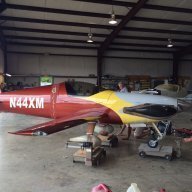
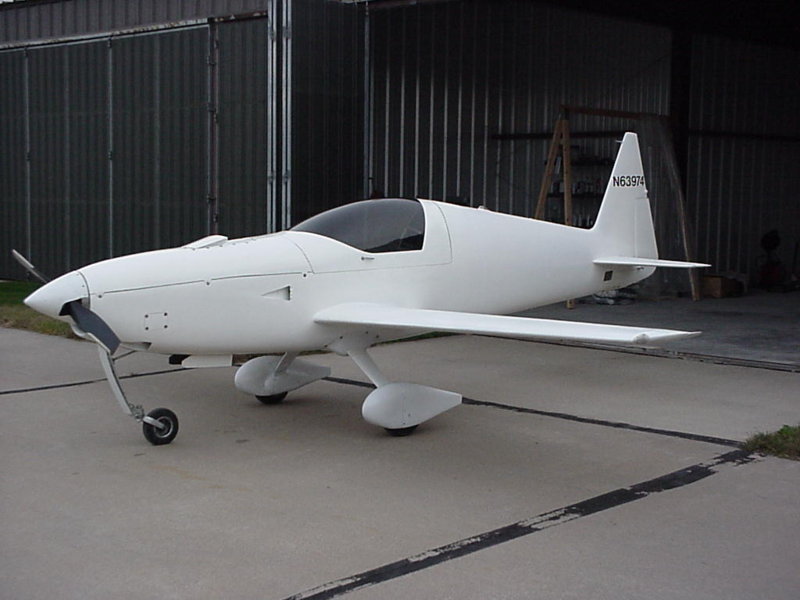
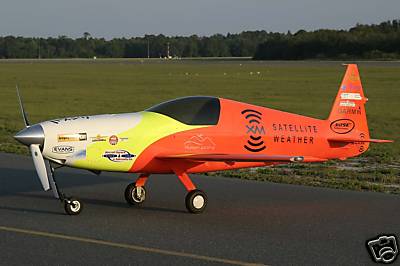
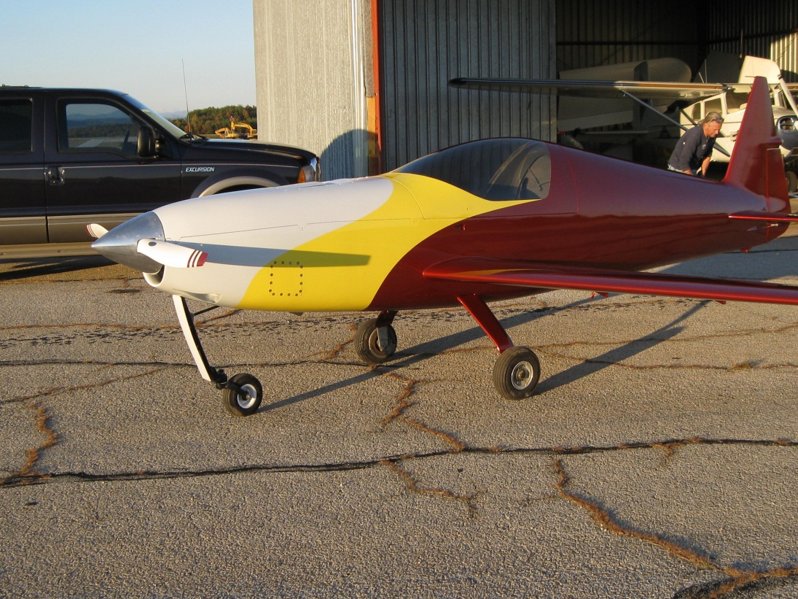

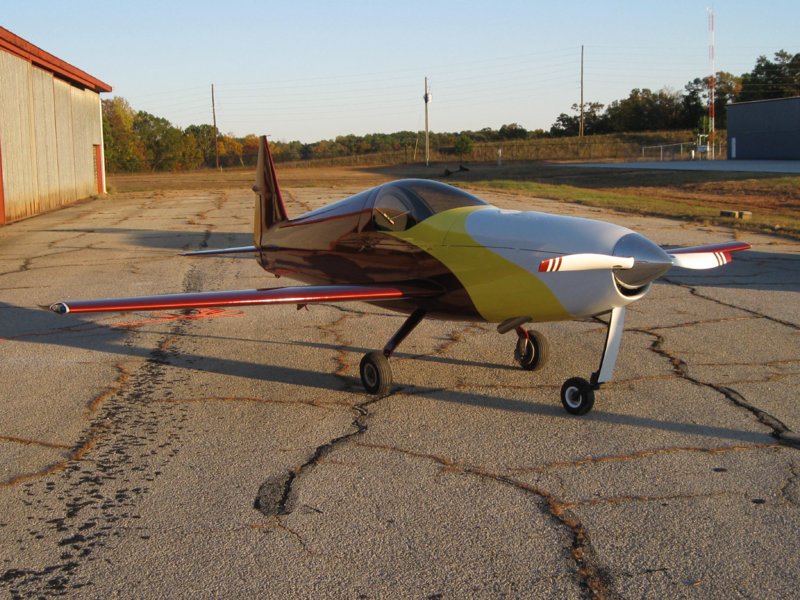
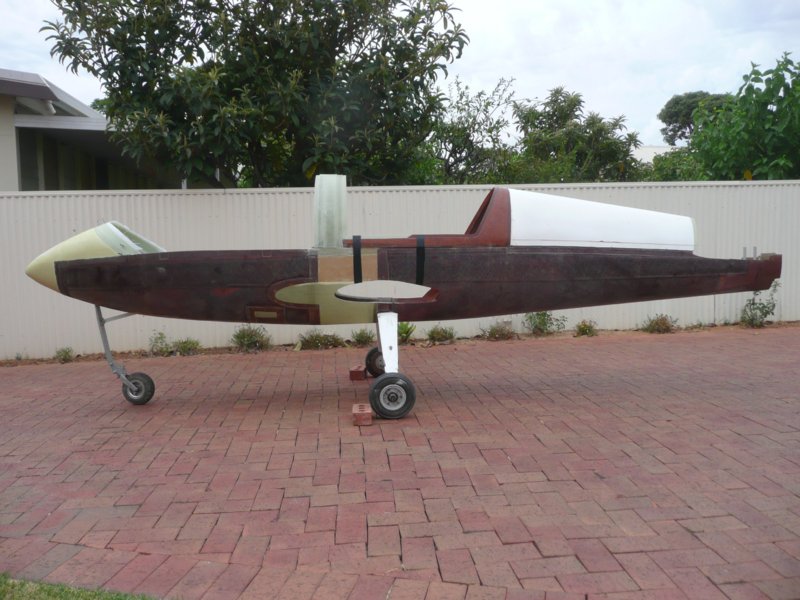
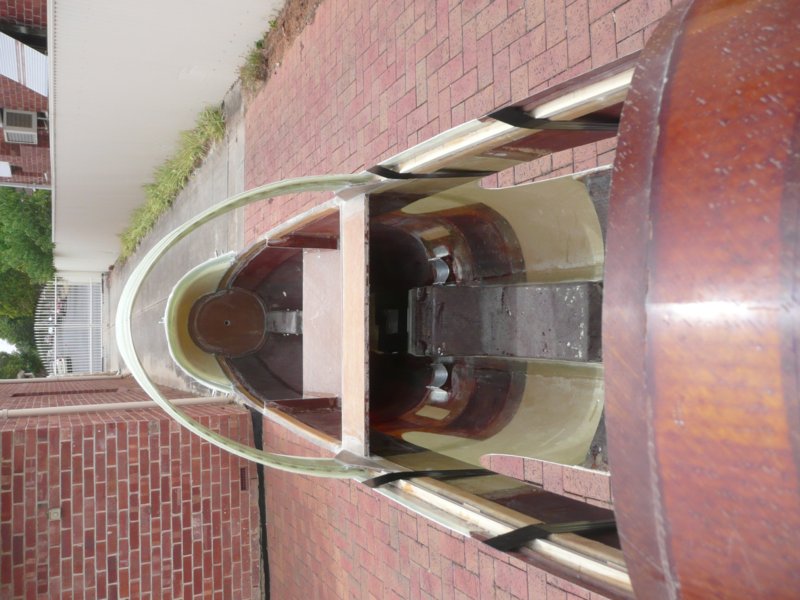
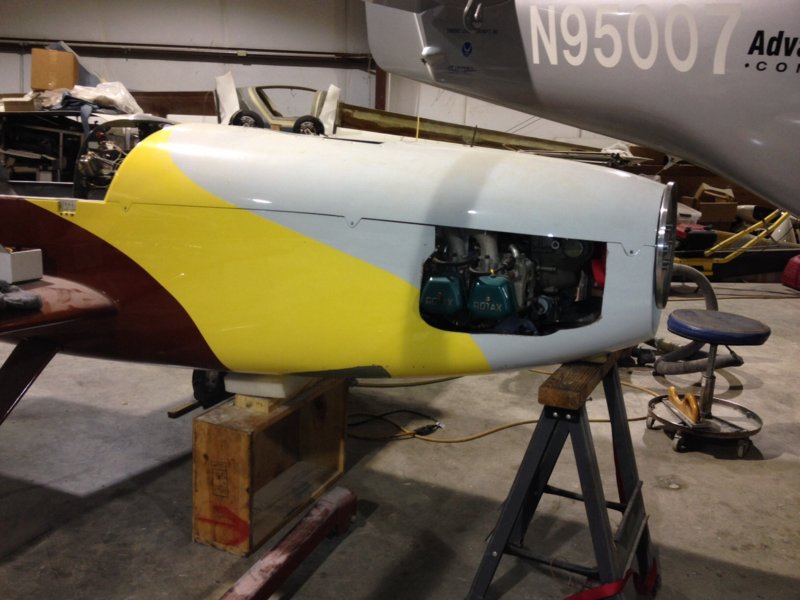
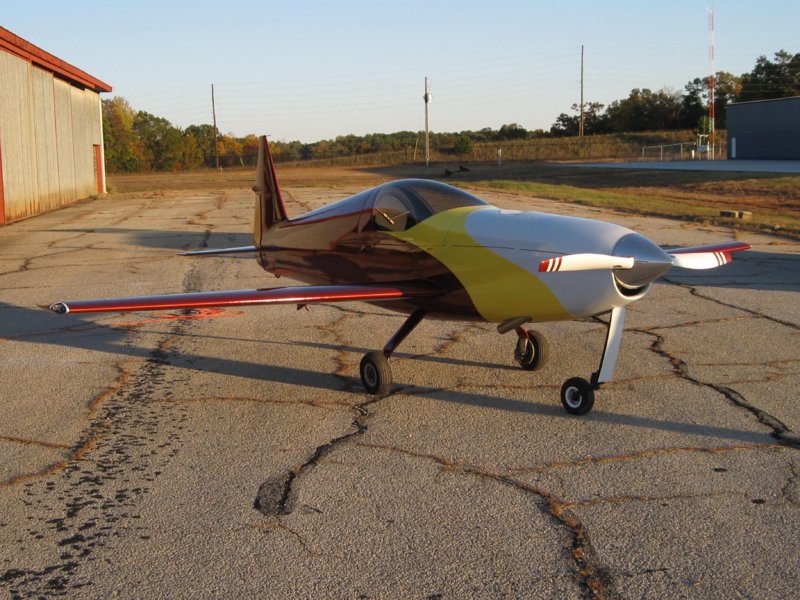
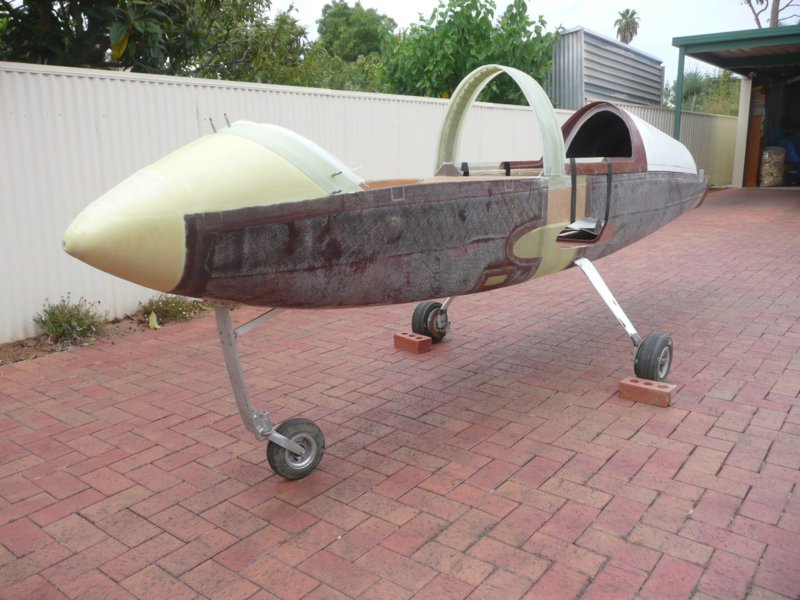
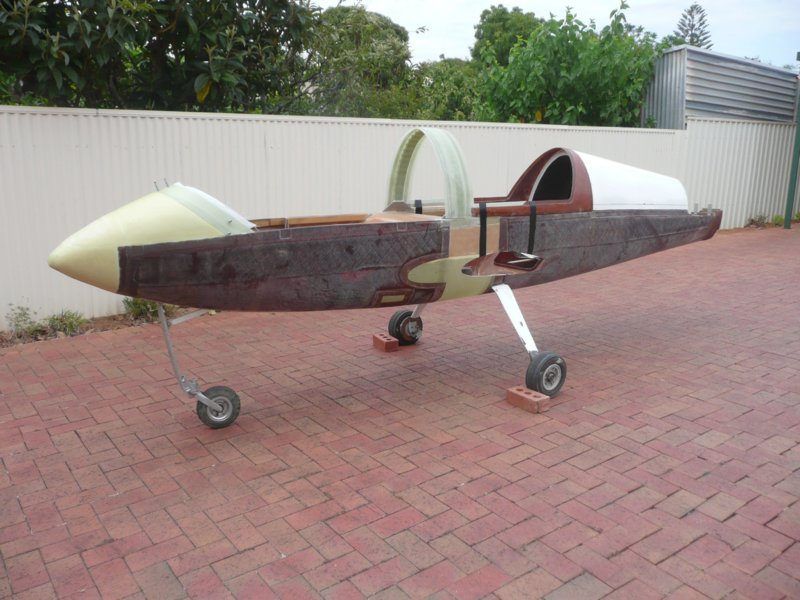
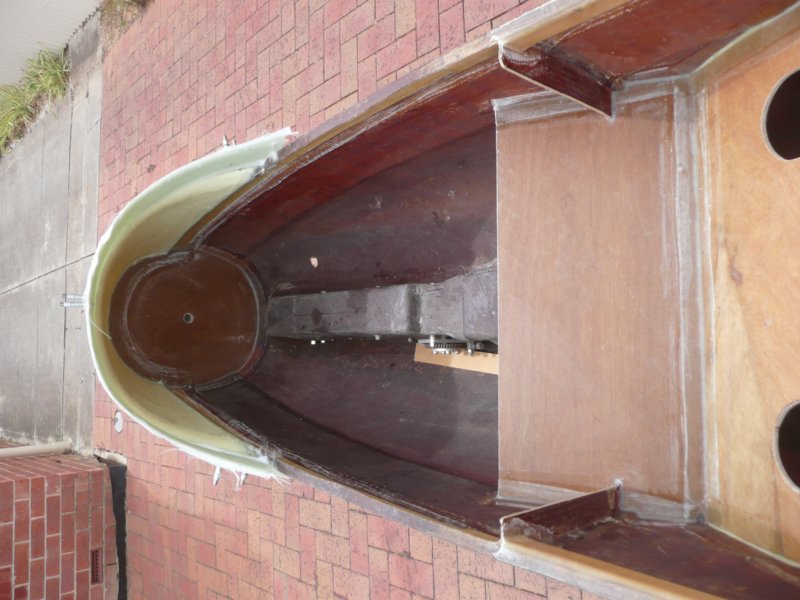
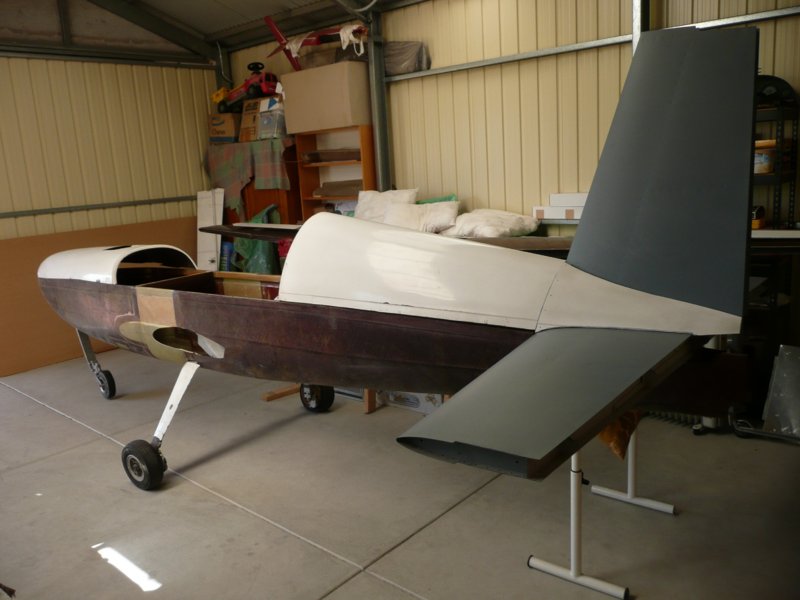
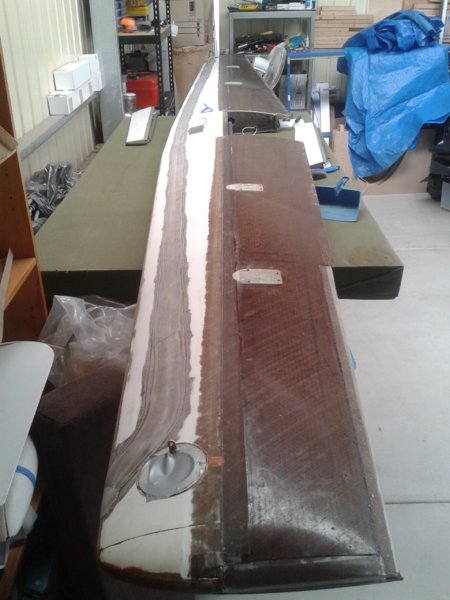
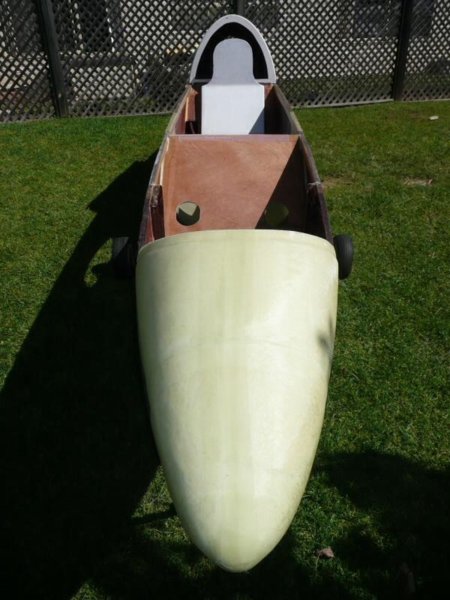
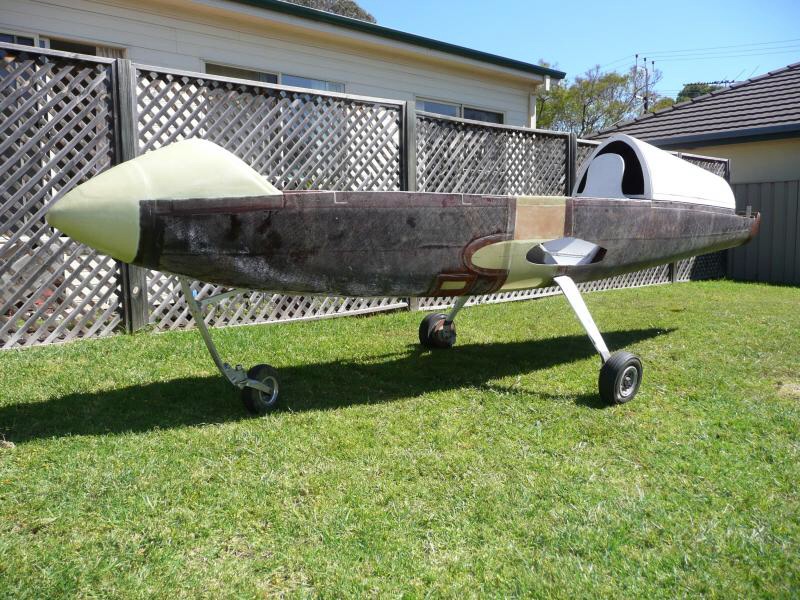
Lightning Bug rebuild
in Aircraft Building and Design Discussion
Posted
Once the Bug had arrived at Lanny's hangar, we needed to sort out the "to-do" list in order to get it back into the air. We came up with the following major items:
1. Rejoin the two fuselage halves where it had been cut for transport;
2. Remove the existing AMW808 engine;
3. Source a Rotax 912ULS for installation to replace the AMW808;
4. Install the Rotax 912ULS, along with its' ancillary systems and equipment;
5. Modify the cowling and structural keel to accept the Rotax;
6. Modify the geometry and mechanism for the retractable nosegear to suit the new engine compartment structure;
7. Remove the main landing gear and re-install it turned around 180 degrees (many years ago, at the direction of the then owner who apparently kept tipping the aircraft on its tail while climbing in, Lanny had swapped the gear orientation which moved the location of the wheels aft around 6");
8. Source and install wheel pants for the main gear;
9. Source a suitable propeller for the aircraft;
10. Complete a comprehensive inspection of the entire aircraft and its' systems to confirm airworthiness;
11. Cosmetically tidy the whole aircraft;
12. Complete an annual inspection on the aircraft; and
13. Ensure all paperwork for the aircraft is in order.
These tasks are still being undertaken but I shall document some of what has been done so far.
To be continued...